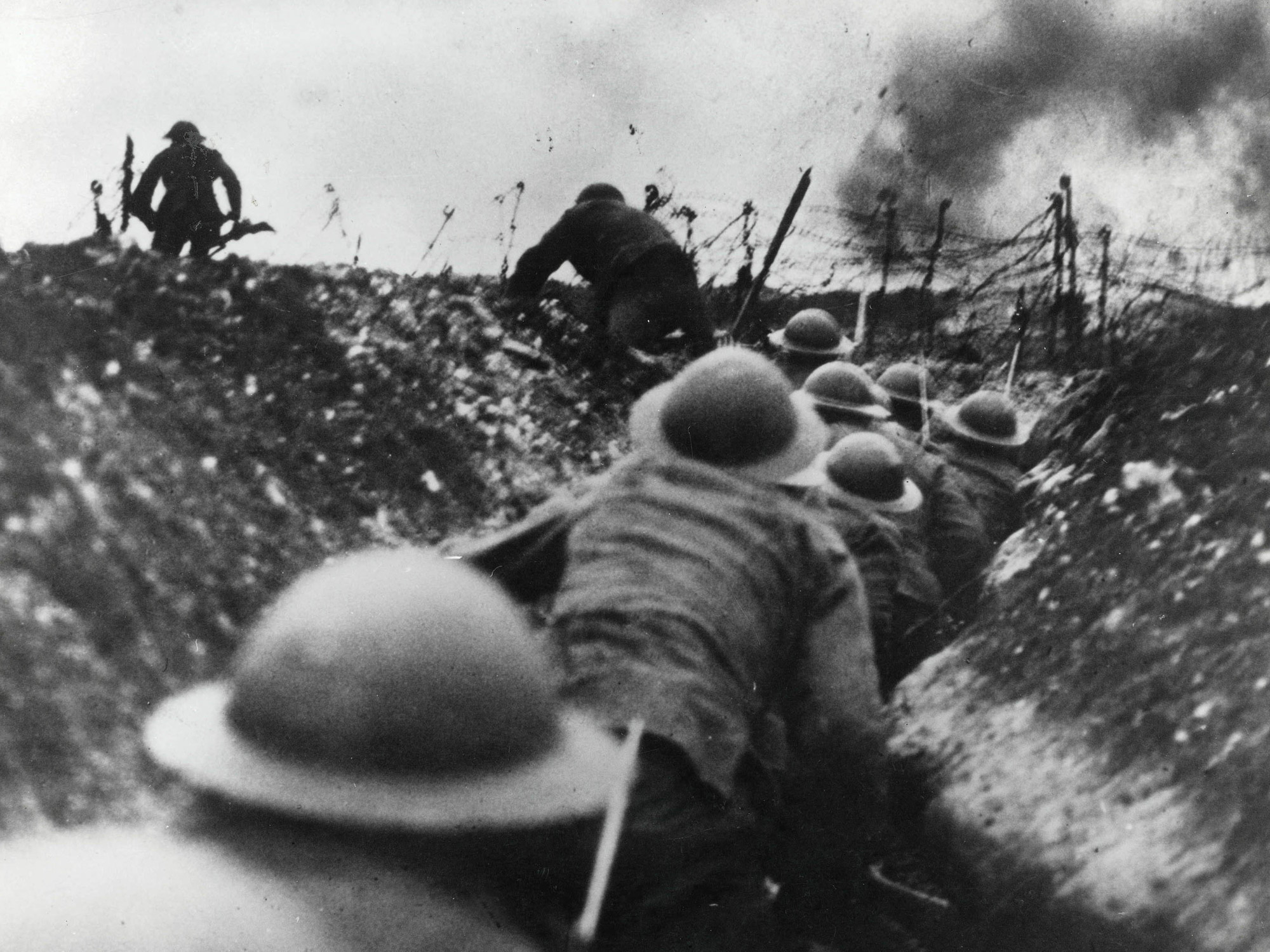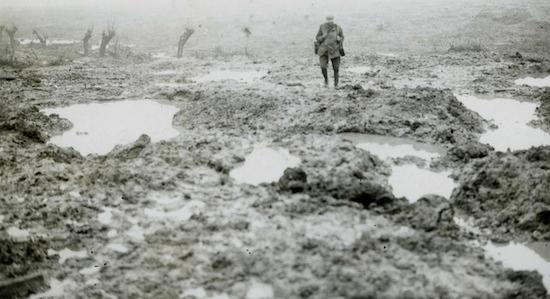Battlefield a Shooting Gallery; Bloodiest 24 Hours of the War.
Worst Day in British Military History
Special to The Great War Project.
(30 June-1 July) The British give the order for an enormous attack at the River Somme on this day, July 1st, one hundred years ago.
Potentially one of the most decisive battles of the war is underway.
“The battle of the Somme,” writes historian Martin Gilbert, “was the Anglo-French attempt to break through the German lines by means of a massive infantry assault.”
The British assemble tens of thousands of infantry to mount the attack. It begins “when nearly a quarter of a million shells are fired at the German positions in just over an hour.”

British infantry on the attack at the Somme, circa July 1916.
It’s an average of 3500 shells each minute. “So intense was the barrage that it was heard on Hampstead Heath, in north London.”
The British fire more shells this week than they use in the entire first year of the war.
Zero hour for the attack is 7:30 a.m. on July 1st. Just before that moment, an enormous explosion shatters the battlefield. “Ten enormous mines,” reports historian Adam Hochschild, “were detonated deep underneath the German trenches.”
British miners have been tunneling for weeks to carry out these explosions. One mine contains thirty tons of high explosives. It rips into the German trenches from below, leaving in one case a crater more than 55 feet deep and 220 feet across.
The British wait two minutes to let the debris, blasted thousands of feet into the air, settle.
This two-minute pause proves crucial for the German defenders. Reports Hochschild, “They gave German machine-gunners time to run up the ladders and stairways from their dugouts and man their fortified posts, of which there were roughly a thousand on the sector of the line under attack.”
The Germans open machine-gun fire. It is withering.
“The five-day artillery barrage had been for naught,”…
…writes Hochschild.
The British are hurt by their own orders. Their attacking units are ordered to walk, not run. They come at a steady slow pace, writes Hochschild. It seems to some German soldiers that the slow pace of the British infantry attack suggests the British assume they will meet little resistance as they near the first German trenches.
The Germans unleash their own artillery. Their shrapnel shells are especially effective against the slow moving British infantrymen.
According to one German account, “all along the line men could be seen throwing their arms into the air and collapsing never to move again. Badly wounded rolled about in their agony…with…cries for help and the last screams of death.”
The plans for an orderly move forward, observes Hochschild, break down almost immediately. The advancing British lines disintegrate. Soldiers seek the protection of shell holes.

The Somme battlefield.
When they do reach the forward German trenches, writes one survivor, “I was absolutely amazed to see it intact, after what we had been told.” The battlefield becomes a shooting gallery.
The lethal toll of the day is staggering. “Of the 120,000 British troops who went into battle on July 1st 1916,” writes Hochschild, “more than 57,000 were dead or wounded before the day was over, nearly two casualties for every yard of the front.”
“Nineteen thousand British soldiers were killed, most during the attack’s first disastrous hour. Another 2000 badly wounded would die in hospitals”
According to Hochschild, there are 8,000 German casualties.
“It was the bloodiest 24 hours any army suffered in this war.”

British soldier at Somme rescued by comrade, circa July 1916.
Saving the wounded is impossible. “The dead and wounded,” reports Hochschild, “include hundreds of stretcher bearers themselves” and there are not enough men to carry the stretchers. In fact stretchers run out.

Taking the names of the wounded at the Somme.
“Many wounded in the first day never made it off the battlefield.” For weeks afterward, “their fellow soldiers came upon them in shell holes, where they had crawled for shelter, taken out their Bibles, and wrapped themselves in their waterproof ground sheets, to die, in pain and alone.”
War historian John Keegan calls the disaster of the first day of the Somme attack “the greatest loss of life in British military history.”

Vivid and intense. And so frightfully sad. Thank you, Mike.
It is difficult to believe that we could consider this period of humanity’s dwelling on this earth in any way civilized.
In light of current events, it is clear that we have a long way to go before we are in a meaningful way evolved.
I’ve been reading the online editions of The Guardian and The Telegraph. If you want to read more about the battle, the men who fought at the Somme, the cemetery created in their honor/memory, I highly recommend you make your way over to the sites. Incredible coverage of the centenary.
Again Mike, thanks for posts… it’s been an enlightening and educational two years (unfortunately there are 2 1/2 more to come!).
Mike, hello. These stories, especially this one, are wrenching and heartbreaking. Thanks for telling all of us about the human tragedies of war. Reading this on a day of news from central Baghdad with scores killed by ISIL self credited bombings.
Jo Anne
Thank you Jo Anne. There’s so much in the history of the First World War that resonates today. I’m glad you find these stories worthwhile. All the best.